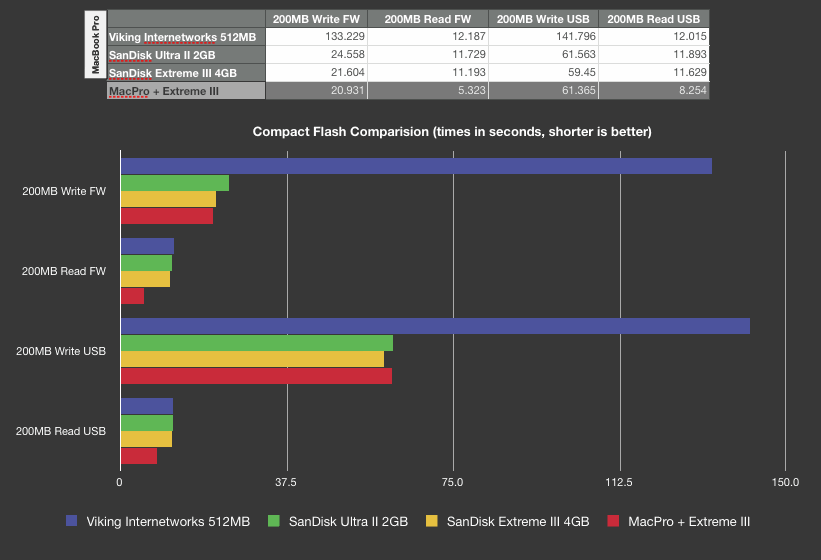I recently got a new 4GB CF card, and I have a couple CF card readers. I was inspired to see how much of a difference in speed I really get on my main machine, a 15” MacBook Pro, using various combinations of cards and readers. Like my Canon 17-40L vs 18-55 Lens Comparison , this is not a scientific shootout, by any means. It’s a quick real-world test of the equipment I’ve got on hand. Your results will most certainly vary…
The Players
- CF Card Readers
- Lexar Pro Series Compactflash Readers Firewire 400
- Lexar USB 2.0 6-in-1 Card Reader
- CF Cards
- SanDisk 4GB Extreme III
- SanDisk 2GB Ultra II
- Viking 512MB
The Script
I created a test file of exactly 200M [created with openssl rand (10241024 200)]. For each pair of reader and card, I wrote the file using ‘time cp 200M.dat /Volumes/CFCard/200M.dat’ and recorded the real time spent. I then read the same file back off the card to a clean location on my local hard drive. All tests were performed on my 15” MacBook Pro, and in addition, I tested the highest-performance configuration with a Quad-core Mac Pro as well.
The Numbers

The Conclusions
A few conclusions I’ve drawn from this test:
- Higher-end CF Cards yield dramatically better write performance. This is critical not so much when writing to them from a computer (a rare case), but is very important when shooting burst mode, especially with RAW files. You never want slow card writes to be blocking you when the perfect shot frames itself in your viewfinder! The Extreme III was the clear winner for write performance.
- Reading on a MacBook Pro is limited by the local hard drive speed, not by the bus speed, card speed, or card reader speed. This was the biggest surprise to me. It turns out that on my laptop setup, all the read speeds were in the same range. However, you’ll see on the Mac Pro (with a much faster bus and local drives), read performance was significantly higher.
So I would say, if you are a serious shooter, with high-volumes of data, your best bet is to get a fast computer with fast drives. Next, you’ll want a great FW card reader (there are FW800 versions of the Lexar Pro series available, which I didn’t have on-hand for this test). Either way, be sure you have a high-write-performance card, as this effects not only post-shooting workflow, but also allows you to be more agile when shooting in the field. Never let your equipment get in the way of your art…